9 Ways to Improve NPS Response Rates
Read More
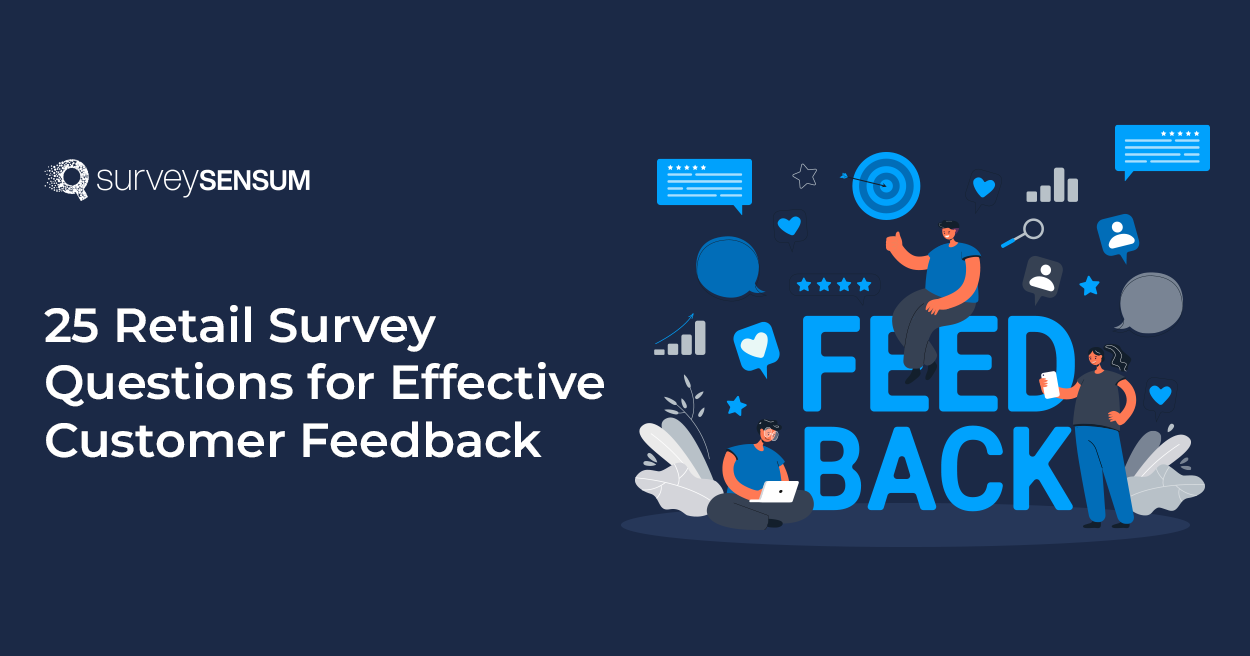
Picture this: You walk into a store with a specific item in mind, but upon arrival, you’re overwhelmed with options. You start to feel unsure and maybe even a bit frustrated. Just when you think you might have to leave empty-handed, a friendly and helpful staff member swoops in to save the day.
This scenario may seem simple, but it’s critical for any retail business. Customer satisfaction can make or break a company’s reputation which is why retailers should be aware of what’s working and what’s not for their business.
But how? With the help of retail surveys.
By gathering customer feedback, businesses can get valuable insights into their retail customer experience.
In this blog, we’ll explore the importance of retail surveys and provide you with the top 25 retail survey questions to ask your customers. Whether you’re a small business owner or a big retail corporation, this blog is for you.
So, let’s get started and uncover the power of retail surveys!
Retail surveys are used to gather customer feedback about their shopping experiences. They are a form of market research that helps businesses understand what their customers think and feel about their products, services, and overall customer experience.
Retail surveys can be conducted through various methods, such as online surveys, in-store surveys, email surveys, and phone surveys.
They usually contain a set of questions that are designed to gather specific information about the customer’s experience, such as their satisfaction level, what they liked and disliked, what can be improved, and their overall opinions.
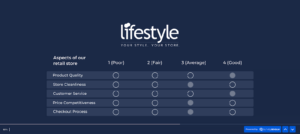
But are they really essential?
Yes, retail surveys are essential for businesses. They are a valuable tool for gathering feedback from customers about their shopping experience, opinions, and expectations.
They are!
With retail surveys, you can understand your customers well, and accordingly, you can customize your business’ products and services to deliver what your customers expect from you.
Here are some of the advantages of using retail surveys in your organization:
To take advantage of retail surveys, launch it now.
Sign up to SurveySensum to create Free Retail Surveys
But do you know what questions to ask your customers post-shopping?
Let’s find it out.
While designing customer feedback retail surveys, most businesses get stuck on – what question to ask.
That’s why to know what to ask your target audience– keep reading.
The following section on the types of retail survey questions covers different types of questions with examples to ask effective questions.
Because if you don’t ask effective questions then you won’t get valuable customer insights.
Net Promoter Score (NPS) is a widely used metric in the retail industry to measure customer loyalty and satisfaction. NPS surveys can be either relational or transactional, depending on the scope of the survey. Here are some examples of retail survey questions for each type:
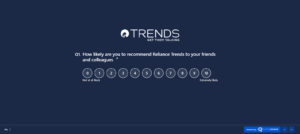
Relational NPS:
Transactional NPS:
You can also have a look at the 5 best NPS survey questions.
It is recommended not to use transactional NPS surveys after every single transaction. This is because loyalty takes time to build, and measuring it too frequently can lead to inaccurate results.
Instead, Relationship NPS surveys are best for measuring overall loyalty and should be taken once a quarter or twice a year. On the other hand, if you want to measure the satisfaction of each individual transaction, CSAT surveys are the way to go!
Learn more about the difference between transactional and relationship NPS surveys.

CSAT (Customer Satisfaction Score) is a popular type of retail survey question used to measure how satisfied customers are with a specific product, service, or experience. Here’s an example of a CSAT question:
→ “On a scale of 1-5, how satisfied were you with your recent shopping experience at our store?”
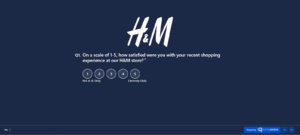
Customers can rate their satisfaction on a scale of 1-5, with 1 being very unsatisfied and 5 being very satisfied. The results are then analyzed to determine the overall customer satisfaction level, and improvements can be made based on the feedback received.
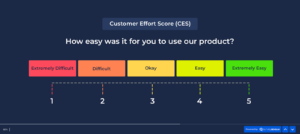
Customer Effort score surveys are another type of retail survey used to measure the customer’s ease of experience with a brand, product, or service. It is a good indicator of customer loyalty and can help businesses identify potential areas of improvement in their processes.
When should you use this?
CES Retail Survey can be used to assess the level of effort required by customers to complete a purchase, make a return, or resolve an issue with a product or service.
You can ask questions like → How easy was it for you to find our nearby store?
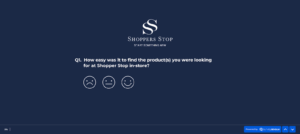
By identifying the friction that your customers face, you can improve those areas to deliver a great customer experience.
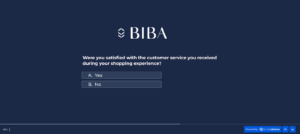
Binary survey questions are typically designed to elicit a “yes” or “no” response from the survey respondent. Here are some examples of binary survey questions that can be used in a retail setting:
All these given types of questions are the best shopping experience question examples to begin with. However, your survey doesn’t end here.
Asking follow-up questions is crucial.
You must ask follow-up questions to get the most insightful retail survey feedback.
Why?
Because asking follow-up questions gives your customers a space to appreciate or criticize your products, services, or business as a whole in their own words.
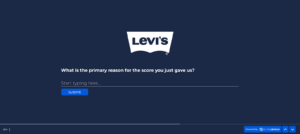
Retail survey questions on products and pricing are questions that are designed to gather information from customers about their opinions and experiences regarding the products and pricing of a retail store.
These questions can be used to evaluate customer satisfaction and identify areas for improvement in the product and pricing strategies of the store. Here are some example questions:
Retail survey questions on product stock are a set of questions designed to gather feedback from customers about the availability of products in a retail store.
These questions aim to evaluate how often customers encounter stock issues, which products are frequently out of stock, and how customers feel about finding the product they are looking for out of stock.
To gauge your customer’s experience with your in-store product stock, ask the questions given below:
A retail survey on service asks customers about their experiences with a company’s customer service, both online and in-store.
The questions aim to identify areas where the company can improve, such as staff friendliness, product knowledge, ease of checkout, and speed of delivery. Gathering feedback through these questions helps retailers enhance the customer experience and increase loyalty.
Here are some possible retail survey questions on service for both online and in-store experiences:
The retail survey questions on returns aim to gather feedback from customers about their experiences with the return process, both in-store and online.
The questions can help retailers identify areas where they can improve the return process, such as clarity of instructions, ease of initiating a return, speed of refund or exchange, and fairness of return policies.
Here are some possible retail survey questions on returns for both online and in-store experiences:
The demographic questions can be used to segment the survey results by different groups of customers and to better understand their shopping preferences and behaviors.
Here are some examples of demographic questions that can be used in a retail survey:
Note: It is important to keep in mind that some customers may not feel comfortable sharing certain information, so it is recommended to keep the number of demographic questions to a minimum and to only ask for information that is relevant to the survey objectives.
Retail questions on brick-and-mortar (offline) stores are designed to gather information from customers about their experiences with physical retail locations.
These questions can evaluate the customer’s satisfaction level with the store, identify areas for improvement, and provide insights to the store management team.
Here are some example questions:
Launching an open-ended follow-up question can help you comprehend and analyze your customer’s thoughts behind the given score on the first question. Also, the data will help you to improve your products and services.
So ask the following open-ended follow-up question:
Use and customize all these above-mentioned questions as per your business requirements. And continue improving and delivering the best customer service and experience.
Here are the top 25 retail survey questions that you must ask your customers.
You know the questions you’ve sent the survey. But what happens when your customers don’t respond to you?
To improve your retail survey response rate, you need to take care of the following 5 points:
By implementing these 5 key strategies, you will observe a boost in your retail survey response rate over time.
We’ve discussed a lot about retail surveys, so it’s time to wrap it up.
In conclusion, conducting a retail survey can provide businesses with valuable insights into customer preferences, attitudes, and behaviors. Using this information, companies can make data-driven decisions and enhance the retail experience, ultimately resulting in increased customer satisfaction and loyalty.
However, creating a well-designed and effective retail survey can be time-consuming and challenging. This is where SurveySensum can help.
As an AI-powered retail customer feedback platform, SurveySensum offers a range of survey solutions to help businesses gather accurate, timely, and actionable customer feedback.
Overall, SurveySensum is an excellent solution for businesses looking to conduct effective retail surveys and improve the customer experience.
